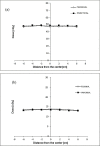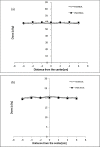Optimization of Clarkson's Method for Calculating Absorbed Dose under Compensator Filters used in Intensity-modulated Radiation Therapy
- PMID: 33134216
- PMCID: PMC7557464
- DOI: 10.31661/jbpe.v0i0.858
Optimization of Clarkson's Method for Calculating Absorbed Dose under Compensator Filters used in Intensity-modulated Radiation Therapy
Abstract
Background: Intensity Modulated Radiation Therapy (IMRT) is extensively used in the treatment of malignancies. Clarkson's method is one of the leading methods for dose calculation at open points present in irregular fields.
Objective: The aim of this study is to generalize the Clarkson's method for dose calculation at points under compensator filters in IMRT method and its application in IMRT quality control as well.
Material and methods: In this experimental study, compensator filters were designed in two forms: flat filter and block piled-up compensator. The measurements for the compensator filters and open fields in 5 and10 cm depths at energy levels (6, 10 and 18 MV) and in fields with different dimensions were performed using "Mapcheck2" dosimeter. The aim of performing calculations is to derive the theoretical dose by the generalized Clarkson's equation and comparing it with data resulted from the measurement for confirming the Clarkson's equation presented.
Results: These results demonstrate the data derived from the generalized Clarkson's method are in good agreement with the data resulted from measurement; the highest error of the proposed equation was 3% for flat filter, and less than 5% for block-piled-up filter. Higher error in the block-piled-up filter compared with the flat filter was due to the presence of leakage between these blocks.
Conclusion: The results of this study demonstrated that the presented equation is reliable and valid, and the proposed equation can be applied for dose calculation at all points under the compensator filter or the shielded areas.
Keywords: Absorbed Dose; Clarkson’s Method; Compensator; Radiation Dosage; Radiotherapy; Radiotherapy, Intensity-Modulated.
Copyright: © Journal of Biomedical Physics and Engineering.
Figures






Similar articles
-
Point dose verification for intensity modulated radiosurgery using Clarkson's method.Med Phys. 2003 Aug;30(8):2218-21. doi: 10.1118/1.1589495. Med Phys. 2003. PMID: 12945987
-
A method for generating intensity-modulated radiation therapy fields for small animal irradiators utilizing 3D-printed compensator molds.Med Phys. 2020 Sep;47(9):4363-4371. doi: 10.1002/mp.14175. Epub 2020 Jul 6. Med Phys. 2020. PMID: 32281657
-
Commissioning compensator-based IMRT on the Pinnacle treatment planning system.J Appl Clin Med Phys. 2011 Mar 8;12(2):3396. doi: 10.1120/jacmp.v12i2.3396. J Appl Clin Med Phys. 2011. PMID: 21587187 Free PMC article.
-
The "Ring" method: a semi-empirical method to calculate dose distributions of irregularly shaped photon beams.Radiother Oncol. 1986 Dec;7(4):363-9. doi: 10.1016/s0167-8140(86)80067-6. Radiother Oncol. 1986. PMID: 3544086 Review.
-
A deadly capillary leak attack. Clarkson's disease: a narrative review.Acta Clin Belg. 2022 Feb;77(1):219-226. doi: 10.1080/17843286.2020.1792685. Epub 2020 Jul 13. Acta Clin Belg. 2022. PMID: 32660359 Review.
References
-
- Haghparast A, Hashemi B, Eivazi M T. Influence of compensator thickness, field size, and off-axis distance on the effective attenuation coefficient of a cerrobend compensator for intensity-modulated radiation therapy. Med Dosim. 2013;38:259. - PubMed
LinkOut - more resources
Full Text Sources
